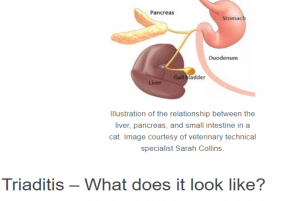18 Feline triaditis -Inflammatory bowel disease, pancreatitis and cholangitis
Pathophysiology
Anatomy : The common bile + pancreatic duct makes cats more likely to share inflammation between the biliary system, the pancreas and the duodenum. This means problems in one tends to lead to problems in the others. Cats with acute necrotizing pancreatitis often have associated suppurative cholangitis and inflammatory bowel disease (triaditis).

Obstruction of the common bile duct allows bile to enter the pancreas and change the duct permeability and pressures. This can lead to pancreatic necrosis.
The association with inflammatory bowel disease (IBD) may be related to:
- IBD being common in cats
- Vomiting with IBD may raise intraduodenal pressure and push duodenal contents up into the duct
- Cats have a wide variety of intestinal flora that can proliferate and infect things
Diagnosis
The individual diseases can be diagnosed separately, but triaditis should be considered when any combination is seen together:
- Vomiting
- Vomiting is a sign noted in both intestinal disease and hepatic disease. Remember, vomiting is not a hallmark sign of feline pancreatitis.
- Icterus
- Icterus can be from hepatic disease. Or it can be from cholangitis secondary to pancreatitis. Bacterial infection in the gut may cause a mild jaundice in the cat.
- Lab values elevated
- ↑ WBC, ↑ ALT , ↑ ALP, ↑ glucose, ↑ cholesterol, ↑ bilirubin
Therapy
Cholangiohepatitis is divided into two categories: acute and chronic.
- Acute or purulent cholangiohepatitis with bacterial infections
Treat with
-
- long term antibiotics
- maybe steroids
- ursodeoxycholic acid
- SAM-E
2. Chronic cholangiohepatitis
Treat with
-
- long term corticosteroid and antibacterial therapy
- ursodeoxycholic acid is also helpful.
Ursodeoxycholic acid is a normal component of bile (and black bear bile contains lots ) that has 3 main functions
-
protection of cholangiocytes against cytotoxicity of hydrophobic bile acids
-
stimulation of hepatobiliary secretion
-
protection of hepatocytes against bile acid–induced apoptosis
Feline pancreatitis
Feline pancreatitis is generally chronic. Treatment includes fluids, anti-emetics, and steroids.
Acute pancreatitis treatment includes fluids, plasma and anti-emetics. Calcium, antihistamines, and low dose dopamine may be considered.
Cats should be fed. Antibiotics may be given to keep bacteria from colonizing the necrotic tissue.
Hence, common triaditis treatments include:
- Antibiotics (if a bacterial infection is detected)
- Anti-nausea meds
- Appetite stimulants
- Gastrointestinal protectants
- Painkillers
- Steroids (to reduce IBD impact)
Resources
Feline Triaditis: Inflammatory Diseases of the Liver, Pancreas and Small Intestine,World Vet Proceedings, 2011
How I treat feline triaditis, NAVC, 2014

